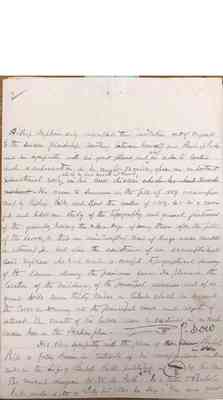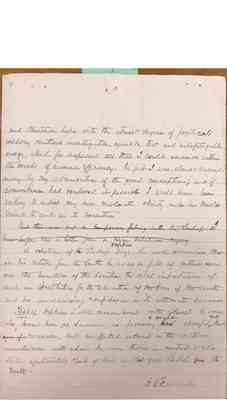Pages
1
Bishop Hopkins at Sewanee
In the interesting illustrated paper on the University of the South recently published by the Churchman, I had hoped to see some mention of Bishop Hopkins of Vermont early connections with the founding of that Institution, but of course the limits of [the?] article did not permit a reference to all the incidents of the early history of the University. With your permission I shall be glad to furnish some account of Bishop Hopkins sojourn at Sewanee in the winter of 1859-60.
The site of the University had been agreed upon and definitely settled at the Meeting of the Board of Trustees held at Beersheba Spgs in July 1858--and in 1859 the Executive Committee was authorized "to employ a landscape gardener for the purpose of laying off and arranging the grounds of the University with due regard to convenience comfort and taste."
The domain which had been acquired embraced some ten thousand acres of the plateau of the Cumberland Mountain about nine miles in length by two to three miles in width, extending to the slopes of the mountain on nearly every side.
Under the resolution Bishop Polk acting on behalf of the Committee desired to procure if possible the services of Bishop Hopkins of Vermont who among his extraordinary and multi[form?] accomplishments was distinguished for his architectural skill and refined taste in landscape gardening.
2
Bishop Hopkins only accepted this invitation out of regard to the sincere friendship existing between himself and Bishop Polk and his sympathy with his great plans and also in order to bestow such a reputation as he might receive upon an important educational [work?] which he had much at heart, [as?] his own diocese. He came to Sewanee in the fall of 1859 accompanied by Bishop Polk and spent the winter of 1859-60 in a careful and laborious study of the topography and general features of the grounds, having the advantage of being there after the fall of the leaves, so that an uninterrupted view of large area could be attained. He had also the assistance of an accomplished civil engineer who had made a careful topographical survey of the domain during the previous year. He planned the location of the buildings, of the principal avenues and of a grand drive some thirty miles in [extent?] which he named the Corso embracing all the principal views and objects of interest. The results of his labor were embodied in a [work?] known here as the Hopkins plan.
His strong sympathy with the plan of Bishop Polk is fully shown in extracts of his correspondence in 1860 [contai?ned?] in the Life of Bishop Polk, published by his son the eminent surgeon Dr. W.M. Polk of N.Y. In a letter to Bishop Polk under date of July 25 1860 he says, "You and your
3
"admirable colleagues, Bishop Elliott have a firm hold upon my "strongest confidence, and my most cordial sympathies. The Lord has [raised?] you up for the noblest work in your day and generation and it is my earnest hope and daily prayer that you may be guided by his unerring wisdom to the full attainment of your most sanguine anticipation" -and writing to Mrs Polk, under date of July 14 1867, he said "My own visit to the grounds intended for the great University of the South was the result of you dear husband's kind partiality. The grand enterprise itself was suggested by his mind and his extraordinary influence and zeal had already already secured for it within his own diocese half a million of dollars. He brought with him to Sewanee at that time a large box entirely filled with the results of correspondence with the leading men in Europe and the scholastic institutions of the Old World, as well as the laborious and thoroughly digested projects for the Southern University, which when completed, was to be the noblest and best endowed in Christendom. And as he unfolded the design and gave me some idea of the vast amount of toilsome work accomplished by Bishop Elliott and himself in its preparation I was amazed and delighted at the combination of original genius lofty lofty enterprise
4
4
and Christian hope with the utmost degree of practical wisdom, cautious investigation, exquisite tact and indefatigable energy, which far surpassed all that I could conceive within the bounds of human efficiency. In fact I was almost carried away by my admiration of the grand conception; and if circumstances had rendered it possible I would have been writing to enlist my own moderate ability under his Master mind to aid in the execution."
A relative of Bishop Hopkins says she well remembers that on his return from the South he was so full of enthusiasm over the beauties of the location, the vital importance of such an Institution for the education of the sons of the South and his unwavering confidence in its ultimate success.
Bishop Hopkins is still remembered with interest by some who knew him at Sewanee, as possessing a bright cheerful and kind manner, and unaffected interest "in the native mountaineer with whom he was thrown in contact & who still affectionately speak of him as that good Bishop from the North."
G. R. Fairbanks



